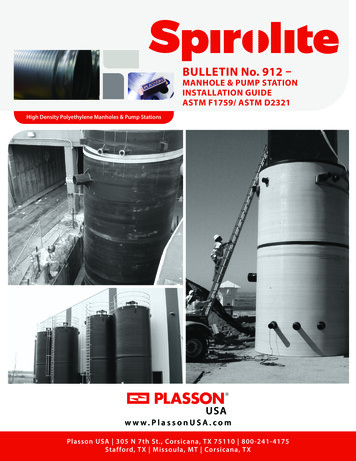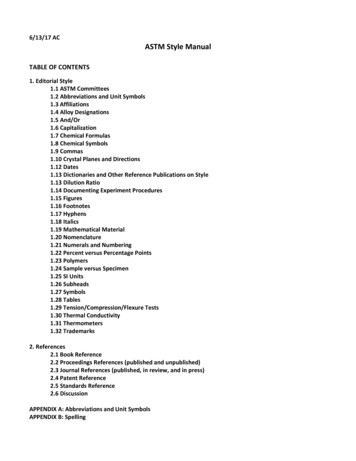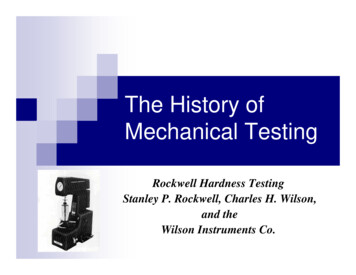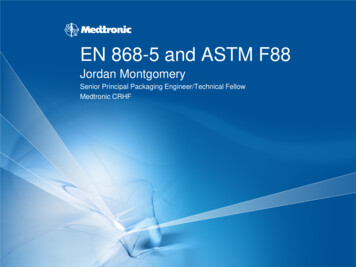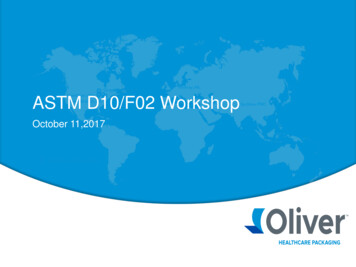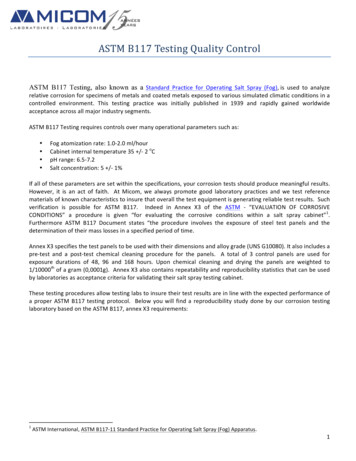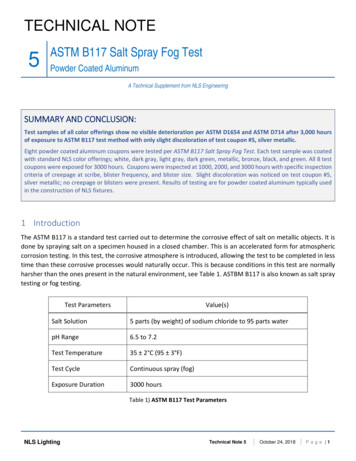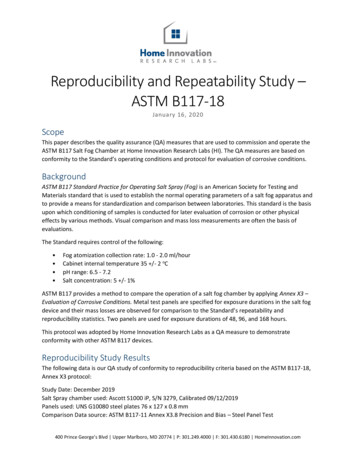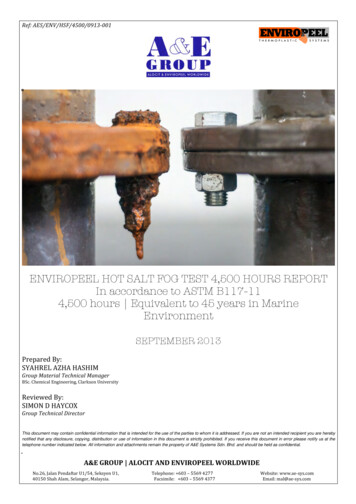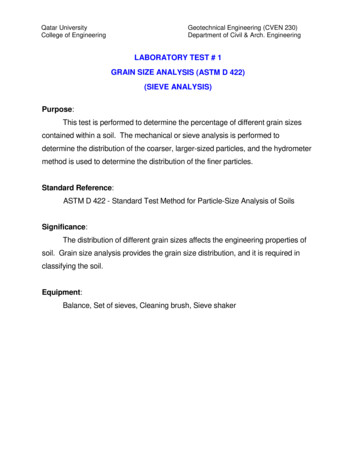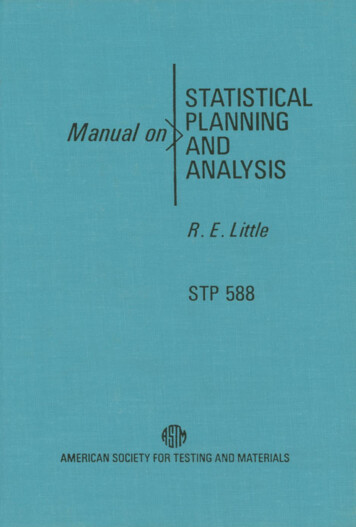
Transcription
MANUAL ONSTATISTICAL PLANNINGAND ANALYSIS FORFATIGUE EXPERIMENTSSponsored byCommittee on PublicationsAMERICAN SOCIETY FORTESTING AND MATERIALSASTM SPECIAL TECHNICAL PUBLICATION 588R. E. LittleUniversity of Michigan, Dearborn CampusAssisted by E. H. JebeEnvironmental Research Institute of MichiganList price 15.0004-588000-30AMERICAN SOCIETY FOR TESTING AND MATERIALS191 6 Race Street, Philadelphia, Pa. 191 03
( ) BY AMERICAN SOCIETY FOR TESTING AND MATERIALS 1975Library of Congress Catalog Card N u m b e r : 75-13060.NOTEThe Society is not responsible, as a body,for the statements and opinionsadvanced in this publication.Printed in Lutherville-Tlmonium, MdNovember 1975
ForewordIn 1949 Committee E-9 on Fatigue published ASTM STP 91, Manualon Fatigue Testing. Seven years later E-9 published ASTM STP 91A, AGuide for Fatigue Testing and the Statistical Analysis of Fatigue Data.Both publications were modest efforts, presenting what was then consideredthe current practice and views of Committee E-9 members. Subsequentlyeffort was expended intermittently in Committee E-9 for over a decade invarious attempts to revise and expand these STP's to reflect advances inthe state of the art and in statistical analyses. This activity ultimately ledto ASTM STP 566, Handbook of Fatigue Testing, and to the presentManual on Statistical Planning and Analysis for Fatigue Experiments.The present manual is the last of several attempts to revise ASTMSTP 91A to include more information on statistical planning of fatigueexperiments. The reader will find in the first two chapters an effort to presentand explain the basic terminology and fundamental concepts of plannedexperiments, and to indicate the necessary steps in a professional statisticalanalysis (using a simple randomized complete block fatigue test programfor purposes of illustration). The last two chapters cover statistical planningof S-N and fatigue strength (response) tests, with specific recommendationsregarding specimen replication; and nonparametric comparison of twocensored life samples, with extensive computer tables.Overall, the intent is to provide sufficient information to permit fatigueinvestigators to conduct fatigue test programs with statistically plannedorganizational structures.In the acknowledgments at the end of this manual I have expressedmy appreciation to those individuals who contributed to this manual.As Chairman of Subcommittee E09.06, I would also like to express mysincere appreciation to all those individuals who worked on variousantecedents to the present manual.R. E. Little, ChairmanASTM Committee E09.06 onStatistical Aspects of Fatigue
RelatedASTM PublicationsHandbook of Fatigue Testing, STP 566 (1974), 17.25, 04-566000-30The Influence of State of Stress on Low-Cycle Fatigue of StructuralMaterials: A Literature Survey and Interpretive Report, STP 549(1974), 5.25, 04-549000-30Fatigue at Elevated Temperatures, STP 520 (1973), 45.50, 04-520000-30
A Note of Appreciationto ReviewersThis publication is made possible by the authors and, also, the unheraldedefforts of the reviewers. This body of technical experts whose dedication,sacrifice of time and effort, and collective wisdom in reviewing the papersmust be acknowledged. The quality level of ASTM publications is a directfunction of their respected opinions. On behalf of ASTM we acknowledgewith appreciation their contribution.A S T M Committee on Publications
Editorial StaffJane B. Wheeler, Managing EditorHelen M. Hoersch, Associate EditorCharlotte E. Wilson, Senior Assistant EditorEllen J. McGlinchey, Assistant Editor
ContentsIntroduction1Chapter 1--Fundamental Concepts in the Statistical Planning (Design) ofFatigue ExperimentsIntroductionOrganizational Structure of Planned ExperimentsPaired Comparison Test ProgramElementary Uniformity Trial Test ProgramCompletely Randomized Design (CRD) Test ProgramRamdomized Complete Block (RCB) Test ProgramElementary Split Plot Test ProgramSummary and PerspectiveAppendix336691618252828Chapter 2--Necessary Steps in Statistical Analysis for Planned ExperimentsIntroductionNecessary Steps in Analysis of Variance (ANOVA) for a Paired Comparison ProgramStep 1 : Write the Mathematical ModelStep 2: Plot the Transformed DataStep 3: Explain the Data (by appropriate parameter estimation)Step 4: Statistical Analysis (generally analysis of variance (ANOVA))Summary343438394145Chapter 3--Planning S - N and Response TestsIntroductionConventional S - N TestsPreliminary and Exploratory TestsReplicated S - N TestsReplication Guidelines for S - N TestingDiscussion of GuidelinesFatigue Strength and Fatigue Limit TestsProbit MethodUp-and-Down MethodTwo-Point Method4646464649515252525454vii3434
viiiCONTENTSChapter 4--Distribution-Free Statistical Tests for Comparing Two CensoredLife Samples (in a CRD Test Program)NomenclatureIntroductionComplete (uncensored) DataCensored DataTest of HypothesisAlternative HypothesesComplete (uncensored) DataMann and Whitney's U StatisticMann and Whitney's TablesCensored DataRun-OutsHalperin's Un StatisticHalperin's TablesAccelerated ComparisonsYoung's Ur StatisticYoung's TablesAppendix IAppendix nces147Acknowledgments149
ASTM SPECIAL TECHNICAL PUBLICATION 588 R. E. Little University of Michigan, Dearborn Campus Assisted by E. H. Jebe Environmental Research Institute of Michigan List price 15.00 04-588000-30 AMERICAN SOCIETY FOR TESTING AND 1 91 6 Race Street, Philadelphia, Pa. 1 91 03 MATERIALS ( ) BY AMERICAN SOCIETY FOR TESTING AND MATERIALS 1975 Library of Congress Catalog


